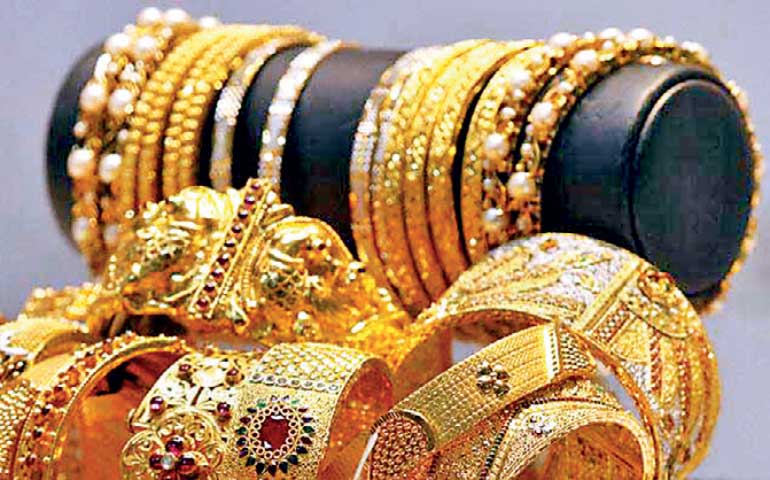Thursday Apr 24, 2025
Thursday Apr 24, 2025
Tuesday, 13 July 2021 02:08 - - {{hitsCtrl.values.hits}}

By Charumini de Silva
Issues over the gold import licence scheme remain unresolved, but industry and officials are hopeful of a swift resolution ahead of a meeting with new Finance Minister Basil Rajapaksa this week.
The discussion with Rajapaksa follows the diverging opinions that emerged following last week’s Cabinet meeting, where it was decided that gold would be brought under the import licence scheme.
A meeting with the Industries Minister Wimal Weerawansa today (13) will precede the discussion with the Finance Minister.
Following the Cabinet decision, a licence fee of 0.4% on the CIF value of the import was to be imposed. However, industry sources called the move unreasonable, noting its negative impact on Sri Lanka’s competitiveness in export markets.
Following the announcement of the Cabinet decision, industry stakeholders held an emergency meeting last week with officials from the State Ministry of Gem and Jewellery Related Industries, the Department of Imports and Export Control, the National Gem and Jewellery Authority, the Export Development Board and Sri Lanka Customs.
“During last week’s meeting with industry, they called on the Government to introduce a mechanism to allow gold imports for export-oriented businesses. The concerns of the exporters regarding the licence scheme were considered immediately and it will be resolved very soon,” State Ministry of the Gem and Jewellery Related Industries Secretary S.M. Piyatissa told the Daily FT.
Industry stakeholders added that any further delay in resolving the matter would cause more loss of export income to the country.
“The authorities requested for more time. As it has been gazetted now, the process to solve the matter will be lengthy. The more time it takes, we will lose orders and earnings in foreign currency,” Sri Lanka Gem and Jewellery Association (SLGJA) Chairman Ahsan Refai said.
He also said that the ad hoc move had resulted in some of gold shipments remaining uncleared.
During the first five months of the year, Sri Lanka’s diamond, gem and jewellery exports increased by 75% to $ 107 million, compared to $ 61 million in the same period a year ago. The industry is also a major supplier for tourists.
Countering industry claims, the State Ministry Secretary pointed out that the export figures of the gem and jewellery were far less compared to the annual import of gold.
“In 2017, Sri Lanka imported gold worth $ 650 million, but gem, diamond and jewellery products export value was only $ 266 million,” Piyatissa said.
He added that the licensing move will help to reform gold imports into the country, while facilitating those who genuinely undertake exports.
“It’s only gold that is imported that is scrutinised at the two border institutions – the Department of Imports and Export Control and Sri Lanka Customs. There are no provisions under the National Gem and Jewellery Authority Act to regulate the gold market in the country.”
High gold imports had been a concern for successive Governments, resulting in the imposition of a 15% import tax in 2018.
It was also highlighted that around 50% of the local gold demand is sourced through old, refined jewelleries obtained from auctions conducted by pawn brokers.
“The market is run by the grey market and a lot of gold was smuggled to India via boats before the Government slapped the 15% tax in 2018. I believe this new move by the Government will help to filter gold imports into the country.”
Given industry concerns, the State Ministry Secretary added that there could be possible amendments introduced to the Act to streamline the process.
According to Central Bank data, gold imports peaked in 2017 to $ 650 million and dipped to $ 439 million in 2018, but a 15% import tax and other factors led to a decline of gold imports in 2019 to $ 2.6 million – it recovered to $ 8.7 million in 2020 following Government relief.
In September last year, President Gotabaya Rajapaksa called for the removal of the 14% income tax on gem and jewellery sales. A loan scheme of Rs. 1 million at a 4% interest rate for jewellery manufacturers and traditional goldsmiths was also introduced as an additional measure to boost the industry.

Discover Kapruka, the leading online shopping platform in Sri Lanka, where you can conveniently send Gifts and Flowers to your loved ones for any event including Valentine ’s Day. Explore a wide range of popular Shopping Categories on Kapruka, including Toys, Groceries, Electronics, Birthday Cakes, Fruits, Chocolates, Flower Bouquets, Clothing, Watches, Lingerie, Gift Sets and Jewellery. Also if you’re interested in selling with Kapruka, Partner Central by Kapruka is the best solution to start with. Moreover, through Kapruka Global Shop, you can also enjoy the convenience of purchasing products from renowned platforms like Amazon and eBay and have them delivered to Sri Lanka.
Discover Kapruka, the leading online shopping platform in Sri Lanka, where you can conveniently send Gifts and Flowers to your loved ones for any event including Valentine ’s Day. Explore a wide range of popular Shopping Categories on Kapruka, including Toys, Groceries, Electronics, Birthday Cakes, Fruits, Chocolates, Flower Bouquets, Clothing, Watches, Lingerie, Gift Sets and Jewellery. Also if you’re interested in selling with Kapruka, Partner Central by Kapruka is the best solution to start with. Moreover, through Kapruka Global Shop, you can also enjoy the convenience of purchasing products from renowned platforms like Amazon and eBay and have them delivered to Sri Lanka.